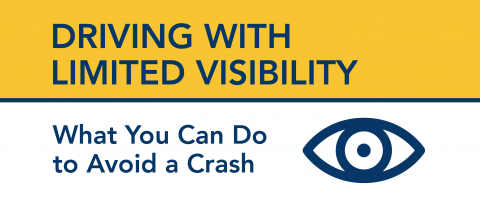Driving with Limited Visibility: What You Can Do to Avoid A Crash

When dealing with limited visibility, the first rule is that you only drive when you must. If you can avoid driving in fog, rain, night-time or other conditions that limit your visibility, you will reduce the risk of becoming involved in a crash. Here’s what you need to know about driving with limited visibility and solutions to reach your destination safely:
- Dirty windows. Clean before starting a trip (inside & outside). Keep the windshield washer fluid reservoir full.
- Objects inside vehicle that create blind spots. Keep cargo and other objects low. Hang clothes in rear on driver’s side.
- Frost or ice on windows. Use defroster before beginning trip.
- Fog, rain, blowing snow. Wait in a safe area for conditions to improve. Reduce your speed, increase your following distance. Use your headlights, or hazard lights if speed is more than 15 miles below posted limit.
- Standing water sprayed onto windshield. Try to anticipate, stay calm, hold wheel firmly, avoid braking.
- Snow on vehicle. Clear all snow and ice from windows, lights, mirrors, hood and roof.
- Low light/night driving. Use headlights, reduce speed, dim dash lights.
- Shadows. Increase scanning, reduce speed.
- Bright sun/glare. Use sunglasses, visor.
- Oversized vehicles. Maintain cushion of safety, increase following distance, approach carefully.
There are times when you cannot control your driving conditions. If you find yourself in a situation of limited visibility, avoid driving if possible. But in a circumstance when you must drive, use these tips to drive with limited visibility and safely reach your destination.